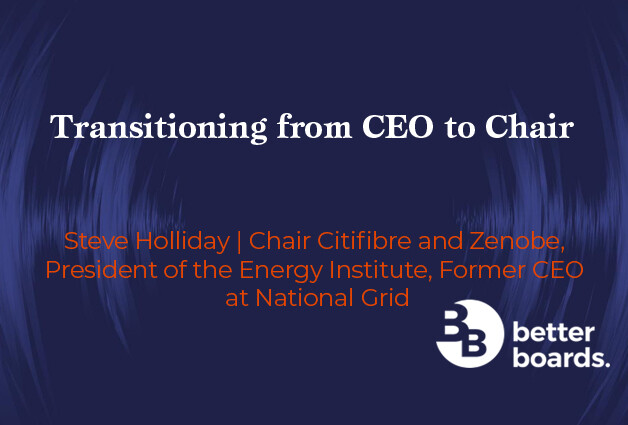Transitioning from CEO to Chair

The subject of this episode of the Better Boards Podcast Series is “Transitioning from CEO to Chair”. Steve Holliday, the Former CEO of National Gird, spoke with Dr Sabine Dembkowski.

The role of an Executive differs significantly from that of a Non-Executive on a board. The desired hands-on qualities that help an Executive thrive may be seen as interference if applied on a board.
Some CEOs make a move to Chair without missing a beat, understanding how to leverage their experience without falling back into old habits. Others fail and fuel preconceptions that make it that put up barriers for those that wish to make the transition.
After serving as Chief Executive of National Grid for almost ten years, Steve has successfully transitioned to prominent Chair and Non-Executive Director roles. Steve is chairing the board of Cityfibre and Zenobe as well as the President of the Energy Institute. Further to these roles, Steve volunteers his time as Vice Chair of the Careers and Enterprise Company, Vice Chair of Business in the Community and previously served as Chair of the Board of Trustees at Crisis, the homeless charity
Some of the key takeaways of the conversation include:
“What it is that you really want?”
Steve provides insights into his thoughts and journey when he was CEO and decided to embark on a different career. “The question really comes down to what is it that you really want?” Steve describes how privileged he felt working with a fabulous team and National Grid. He thought he could not enter into another CEO role that would be as fulfilling as his time with National Grid was. Therefore, he started thinking about his skills, passions, and how he could best use these in a different context. For Steve, this was not just a decision but a journey he prepared for while being CEO.
CEOs who think about making the transition to Chair should be honest with themselves and think about what gives them satisfaction. Steve states, “Suppose the feeling is still there that you need to be involved or have an ear to the ground in the day-to-day, then it is probably unlikely that you are ready to transition from the Executive to the boardroom.”
“Think about how the person fits in”
When asked about what Nomination Committee should consider when deciding on candidates for the board, Steve was clear about what matters. For him, it is the person and their characteristics. The key consideration should be does the candidate fit into the organisation and the team. This applies to filling positions board or for the position of the Chair itself. The people chosen will be expected to be there for six-plus years and there may be factors around succession to be considered. It is a big decision and one that cannot be easily undone.
“Do all the things that are good practice”
From the position of the Chair, Steve stresses the importance of following good practice. This includes implementing best practices in the board review and process review systems. The key is ensuring the time and effort is put in to ensure that you have assembled or are assembling the best people for the board. The question Chairs must ask themselves – “Is this team working genuinely for the best interests of the organisation and the Executive team?”If the answer is not a ‘Yes’ with 100% certainty, Chairs must utilise the board review process to identify the problems and actions to rectify the situation.
Don’t forget to subscribe never to miss an episode of the Better Boards Podcast Series. Available on Apple, Spotify or Google.
To find out how you can participate in the Better Boards Podcast Series or for more information on Better Boards’ solutions, please email us at info@better-boards.com.



